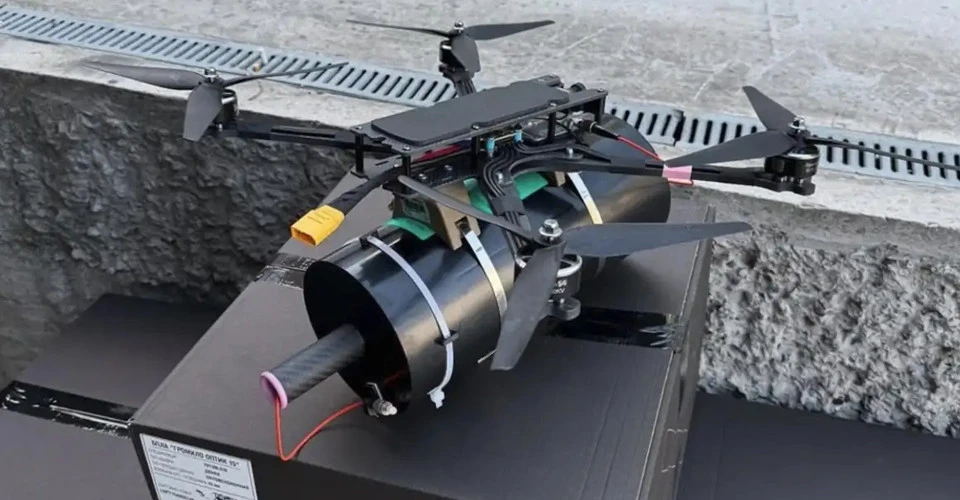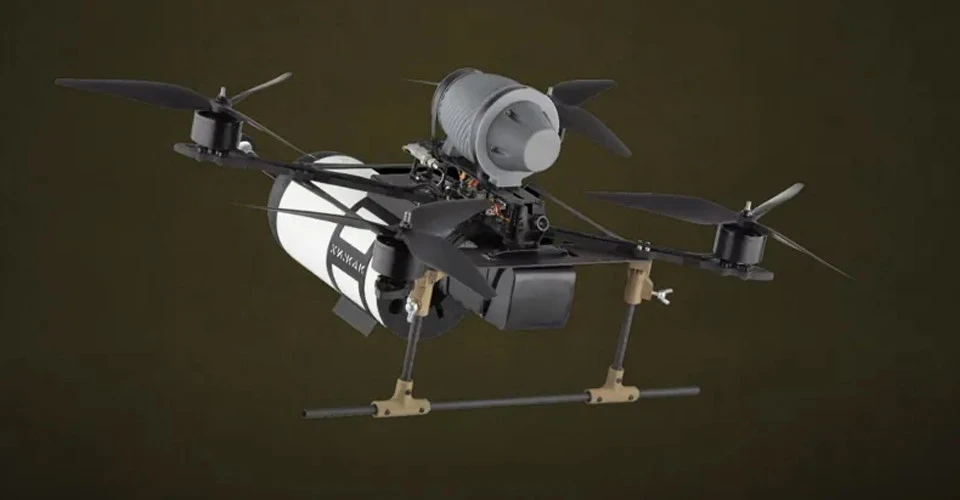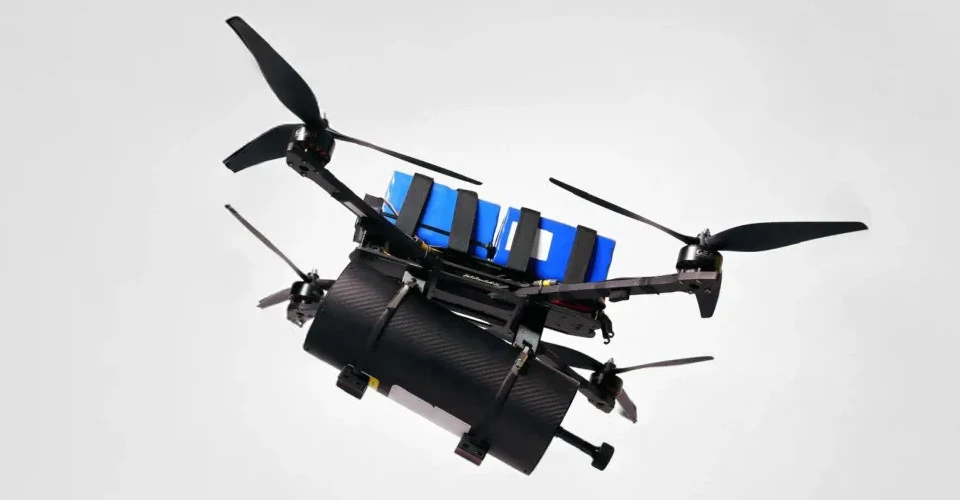Ukraine's Vespa-15 drone: jamming-proof, deadly against fortifications
global.espreso.tv
Sat, 09 Aug 2025 19:06:00 +0300

Content1. Fiber-optic drones and their capabilities2. Ukrainian Armed Forces and fiber-optic drones3. What is the Vespa-15Fiber-optic drones and their capabilitiesFiber-optic controlled drones are a type of unmanned system that uses a thin fiber-optic cable instead of a radio signal to connect with the operator. Here’s how it works: the electrical signal is converted into light, which travels through the cable to the receiver. Then, thanks to a special converter, the light is converted back into an electrical signal. This connection can only be broken by physically damaging the cable.At first glance, these drones look almost the same as regular ones. However, they have a crucial component — a spool of fiber-optic cable installed on the drone or kept by the operator. It looks as if the drone is tied to the operator’s control panel by a thin fiber-optic thread. As the drone moves away, the fiber-optic thread unwinds from the spool — allowing the drone to fly as far as the cable length.Fiber-optic provides ultra-fast and stable data transmission without delays. Unlike radio waves, it is immune to jamming, emits no detectable signals, and prevents the enemy from using electronic warfare tools or heat-seeking missiles against it.Since the cable does not “radiate” signals into the air, the enemy cannot locate the operator’s position or even the drone itself. This is crucial on the frontline, where any signal emission can make a target for counter-battery fire.“Besides rendering electronic warfare ineffective, the operator can receive high-quality images from the drone. Additionally, it becomes impossible to even roughly detect the location of the drone crew using electronic reconnaissance tools,” explains Defense Express.Among the drawbacks — the cable limits the operational range and can tear or tangle on obstacles. Another downside is the “dead weight,” as the spool with the fiber-optic thread takes up payload capacity that could otherwise be used for extra batteries or weapons. The high cost of such drones is also a disadvantage. Ukrainian Armed Forces and fiber-optic dronesThe first to use this weapon were the Russian forces, although it could have been different. The organization Dronarnia developed the first drone of this type early in 2023. However, the military deemed the invention "irrelevant." Serhiy Bezkrestnov (call sign Flash) confirms this — he was on the jury of a Ministry of Defense hackathon where doubts were raised about this technology.In 2024, several Ukrainian companies began producing serial models of fiber-optic drones. For example, last November, the Ukrainian company 3DTech successfully tested the Khyzhak REBOFF in combat conditions.
Ukrainian Armed Forces and fiber-optic dronesThe first to use this weapon were the Russian forces, although it could have been different. The organization Dronarnia developed the first drone of this type early in 2023. However, the military deemed the invention "irrelevant." Serhiy Bezkrestnov (call sign Flash) confirms this — he was on the jury of a Ministry of Defense hackathon where doubts were raised about this technology.In 2024, several Ukrainian companies began producing serial models of fiber-optic drones. For example, last November, the Ukrainian company 3DTech successfully tested the Khyzhak REBOFF in combat conditions. The General Staff of Ukraine also reported on the fiber-optic kamikaze drone Black Widow Web 10.“This is not just a new weapon model — it’s a window of opportunities for further research and development in fiber-optic communication. Robotics and unmanned technologies have taken a new direction. FPV drones with this technology are becoming a major problem for the enemy on the frontline,” the General Staff wrote.In combat conditions, Ukrainian forces have also tested a fiber-optic FPV drone equipped with a disposable handheld anti-tank grenade launcher called Queen Hornets.In April 2025, the defense technology cluster Brave1 conducted Ukraine’s first tests of fiber-optic FPV drones capable of striking enemy targets over 20 km away. By July, Minister of Digital Transformation Mykhailo Fedorov announced that the range of Ukrainian fiber-optic drones had increased from 20 to over 40 km.“Hitting targets at a distance of 40+ km is becoming the new norm for fiber-optic drones. We are developing technology that precisely and flawlessly destroys the enemy,” the minister wrote.Additionally, the Ukrainian parliament passed two bills granting customs and tax benefits to fiber-optic drone manufacturers. The laws allow importing optical fibers, fiber-optic harnesses, cables, and spools used in UAV production and repair without import duties, and exempt from VAT the components necessary for drone defense systems.What is the Vespa-15Vespa-15 (from Italian Vespa – wasp) is a Ukrainian unmanned aerial system with a fiber-optic communication channel, introduced in 2024. This lightweight and compact drone was codified and approved for use by the Armed Forces of Ukraine in May 2025."The agency does not specify that it is a fiber-optic FPV drone, only noting that it has 'increased resistance to enemy electronic warfare measures.' However, the published photo shows a large spool of fiber-optic cable attached to the drone," explained the portal Militarnyi.Neither the Ministry of Defense nor the manufacturer have disclosed exact specifications, flight range, or cost. The Ministry’s website only states that the Vespa-15 unmanned aerial vehicles are capable of "covering distances of several tens of kilometers with significant combat payload."
The General Staff of Ukraine also reported on the fiber-optic kamikaze drone Black Widow Web 10.“This is not just a new weapon model — it’s a window of opportunities for further research and development in fiber-optic communication. Robotics and unmanned technologies have taken a new direction. FPV drones with this technology are becoming a major problem for the enemy on the frontline,” the General Staff wrote.In combat conditions, Ukrainian forces have also tested a fiber-optic FPV drone equipped with a disposable handheld anti-tank grenade launcher called Queen Hornets.In April 2025, the defense technology cluster Brave1 conducted Ukraine’s first tests of fiber-optic FPV drones capable of striking enemy targets over 20 km away. By July, Minister of Digital Transformation Mykhailo Fedorov announced that the range of Ukrainian fiber-optic drones had increased from 20 to over 40 km.“Hitting targets at a distance of 40+ km is becoming the new norm for fiber-optic drones. We are developing technology that precisely and flawlessly destroys the enemy,” the minister wrote.Additionally, the Ukrainian parliament passed two bills granting customs and tax benefits to fiber-optic drone manufacturers. The laws allow importing optical fibers, fiber-optic harnesses, cables, and spools used in UAV production and repair without import duties, and exempt from VAT the components necessary for drone defense systems.What is the Vespa-15Vespa-15 (from Italian Vespa – wasp) is a Ukrainian unmanned aerial system with a fiber-optic communication channel, introduced in 2024. This lightweight and compact drone was codified and approved for use by the Armed Forces of Ukraine in May 2025."The agency does not specify that it is a fiber-optic FPV drone, only noting that it has 'increased resistance to enemy electronic warfare measures.' However, the published photo shows a large spool of fiber-optic cable attached to the drone," explained the portal Militarnyi.Neither the Ministry of Defense nor the manufacturer have disclosed exact specifications, flight range, or cost. The Ministry’s website only states that the Vespa-15 unmanned aerial vehicles are capable of "covering distances of several tens of kilometers with significant combat payload." The system includes several drone modifications designed to perform various tasks both day and night, enabling effective operations in low-visibility conditions."The explosive 'sting' of the Ukrainian Vespa can target not only enemy personnel but also armored vehicles, cars, field fortifications, and more," the Ministry of Defense website states. Drone operators remain at a safe distance inside shelters or dugouts, minimizing risks. The optical fiber connects the control panel directly to the drone without intermediate repeaters, making the system very simple, reliable, and stealthy.
The system includes several drone modifications designed to perform various tasks both day and night, enabling effective operations in low-visibility conditions."The explosive 'sting' of the Ukrainian Vespa can target not only enemy personnel but also armored vehicles, cars, field fortifications, and more," the Ministry of Defense website states. Drone operators remain at a safe distance inside shelters or dugouts, minimizing risks. The optical fiber connects the control panel directly to the drone without intermediate repeaters, making the system very simple, reliable, and stealthy.
 Ukrainian Armed Forces and fiber-optic dronesThe first to use this weapon were the Russian forces, although it could have been different. The organization Dronarnia developed the first drone of this type early in 2023. However, the military deemed the invention "irrelevant." Serhiy Bezkrestnov (call sign Flash) confirms this — he was on the jury of a Ministry of Defense hackathon where doubts were raised about this technology.In 2024, several Ukrainian companies began producing serial models of fiber-optic drones. For example, last November, the Ukrainian company 3DTech successfully tested the Khyzhak REBOFF in combat conditions.
Ukrainian Armed Forces and fiber-optic dronesThe first to use this weapon were the Russian forces, although it could have been different. The organization Dronarnia developed the first drone of this type early in 2023. However, the military deemed the invention "irrelevant." Serhiy Bezkrestnov (call sign Flash) confirms this — he was on the jury of a Ministry of Defense hackathon where doubts were raised about this technology.In 2024, several Ukrainian companies began producing serial models of fiber-optic drones. For example, last November, the Ukrainian company 3DTech successfully tested the Khyzhak REBOFF in combat conditions. The General Staff of Ukraine also reported on the fiber-optic kamikaze drone Black Widow Web 10.“This is not just a new weapon model — it’s a window of opportunities for further research and development in fiber-optic communication. Robotics and unmanned technologies have taken a new direction. FPV drones with this technology are becoming a major problem for the enemy on the frontline,” the General Staff wrote.In combat conditions, Ukrainian forces have also tested a fiber-optic FPV drone equipped with a disposable handheld anti-tank grenade launcher called Queen Hornets.In April 2025, the defense technology cluster Brave1 conducted Ukraine’s first tests of fiber-optic FPV drones capable of striking enemy targets over 20 km away. By July, Minister of Digital Transformation Mykhailo Fedorov announced that the range of Ukrainian fiber-optic drones had increased from 20 to over 40 km.“Hitting targets at a distance of 40+ km is becoming the new norm for fiber-optic drones. We are developing technology that precisely and flawlessly destroys the enemy,” the minister wrote.Additionally, the Ukrainian parliament passed two bills granting customs and tax benefits to fiber-optic drone manufacturers. The laws allow importing optical fibers, fiber-optic harnesses, cables, and spools used in UAV production and repair without import duties, and exempt from VAT the components necessary for drone defense systems.What is the Vespa-15Vespa-15 (from Italian Vespa – wasp) is a Ukrainian unmanned aerial system with a fiber-optic communication channel, introduced in 2024. This lightweight and compact drone was codified and approved for use by the Armed Forces of Ukraine in May 2025."The agency does not specify that it is a fiber-optic FPV drone, only noting that it has 'increased resistance to enemy electronic warfare measures.' However, the published photo shows a large spool of fiber-optic cable attached to the drone," explained the portal Militarnyi.Neither the Ministry of Defense nor the manufacturer have disclosed exact specifications, flight range, or cost. The Ministry’s website only states that the Vespa-15 unmanned aerial vehicles are capable of "covering distances of several tens of kilometers with significant combat payload."
The General Staff of Ukraine also reported on the fiber-optic kamikaze drone Black Widow Web 10.“This is not just a new weapon model — it’s a window of opportunities for further research and development in fiber-optic communication. Robotics and unmanned technologies have taken a new direction. FPV drones with this technology are becoming a major problem for the enemy on the frontline,” the General Staff wrote.In combat conditions, Ukrainian forces have also tested a fiber-optic FPV drone equipped with a disposable handheld anti-tank grenade launcher called Queen Hornets.In April 2025, the defense technology cluster Brave1 conducted Ukraine’s first tests of fiber-optic FPV drones capable of striking enemy targets over 20 km away. By July, Minister of Digital Transformation Mykhailo Fedorov announced that the range of Ukrainian fiber-optic drones had increased from 20 to over 40 km.“Hitting targets at a distance of 40+ km is becoming the new norm for fiber-optic drones. We are developing technology that precisely and flawlessly destroys the enemy,” the minister wrote.Additionally, the Ukrainian parliament passed two bills granting customs and tax benefits to fiber-optic drone manufacturers. The laws allow importing optical fibers, fiber-optic harnesses, cables, and spools used in UAV production and repair without import duties, and exempt from VAT the components necessary for drone defense systems.What is the Vespa-15Vespa-15 (from Italian Vespa – wasp) is a Ukrainian unmanned aerial system with a fiber-optic communication channel, introduced in 2024. This lightweight and compact drone was codified and approved for use by the Armed Forces of Ukraine in May 2025."The agency does not specify that it is a fiber-optic FPV drone, only noting that it has 'increased resistance to enemy electronic warfare measures.' However, the published photo shows a large spool of fiber-optic cable attached to the drone," explained the portal Militarnyi.Neither the Ministry of Defense nor the manufacturer have disclosed exact specifications, flight range, or cost. The Ministry’s website only states that the Vespa-15 unmanned aerial vehicles are capable of "covering distances of several tens of kilometers with significant combat payload." The system includes several drone modifications designed to perform various tasks both day and night, enabling effective operations in low-visibility conditions."The explosive 'sting' of the Ukrainian Vespa can target not only enemy personnel but also armored vehicles, cars, field fortifications, and more," the Ministry of Defense website states. Drone operators remain at a safe distance inside shelters or dugouts, minimizing risks. The optical fiber connects the control panel directly to the drone without intermediate repeaters, making the system very simple, reliable, and stealthy.
The system includes several drone modifications designed to perform various tasks both day and night, enabling effective operations in low-visibility conditions."The explosive 'sting' of the Ukrainian Vespa can target not only enemy personnel but also armored vehicles, cars, field fortifications, and more," the Ministry of Defense website states. Drone operators remain at a safe distance inside shelters or dugouts, minimizing risks. The optical fiber connects the control panel directly to the drone without intermediate repeaters, making the system very simple, reliable, and stealthy.





